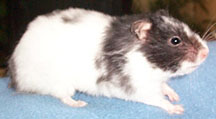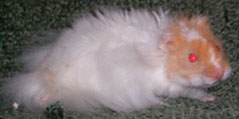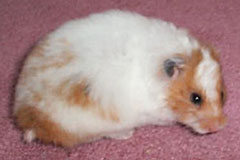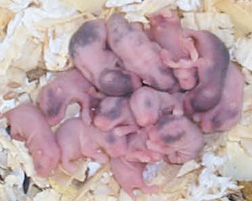
Contents
RRH Index
Extreme Dilute
Syrian Hamsters
Description
History
Genetics
Breeding
Experimental Proofs of
Gene Character and
Transmission
Albinism
ED Photo Gallery
Recessive Dappled
Syrian Hamsters
Description
History
Genetics
Breeding
Experimental Proofs of
Gene Character and
Transmission
Comparison to Other
Patterns
Testing for Allelism with
Dominant Spot
RD Photo Gallery
Working on Type
Syrian Hamster
Genetics
Contact
|
Testing for Allelism Between It is established that Recessive Dappled is a new recessively transmitted pattern. Since it shares so many phenotypic features with Dominant Spot, we wondered if the two genes could be allelic. This would mean that the RD gene is a variant of the DS gene, occupying the same locus on the chromosome. If this were true, then a hamster could have Ds (the symbol for Dominant Spot), ds (the symbol for wild type) or rd (the symbol currently used for Recessive Dappled) on each of two chromosomes. If the genes are unrelated and each has its own locus, Of interest is that in mice there is a variant of the dominant white spotting gene called panda-white wherein color is restricted to the head and the base of the tail.
The most important part of the test was selecting the hamsters to use. We needed:
In addition to the patterns mentioned, both of these hamsters were Banded. This wasn't an ideal situation since care needed to be taken to differentiate RD from DS/Banded, but it was the best available choice at the time. The resulting litter was expected to be roughly 1/2 DS with all pups carrying RD. It has been shown before that when DS is crossed with RD, the litter is DS or solid with no intermediate patterning. What we wanted was a DS pup to cross to another RD. Shown below on the left is a Golden male saved from the litter produced by the above cross. He at first looks RD but is actually a DS Banded. The pigmentation around his head is assymetrical and does not encompass the ears (unlike RDs).
Results here depended on whether DS and RD are co-alleles or not. The second cross was the DS pup (carrying RD) to an unrelated RD female (above right) from a line with no other patterns.. If they are not allelic: DsdsRdrd x dsdsrdrd
Disregarding the Banded factor, the expected outcome is 25% each Dominant Spot, Recessive Dappled, Dominant Spot/Recessive Dappled, and wild type. It may be very hard to distinguish the DS/RD combination from RD alone so there may appear to be a preponderance of RDs. If they are allelic: We will need a new symbol for the rd gene identifying it as an allele of Ds. Since it is recessive, it will be designated ds rather than Ds, but will need a differentiating superscript for which we can retain the rd. The same cross is as follows:
The litter will be about 1/2 Dominant Spot and 1/2 Recessive Dappled. The significant aspect is that there can be no wild type individuals here. If even one pup without either pattern appears, then DS and RD cannot be alleles of each other. However, if no wild type pups are produced, then this could be an event of chance. This cross would need to be repeated many times, each and every time generating only patterned animals, to say with some confidence that DS and RD are allelic.
Their litter of 14 included one solid Golden and one Banded Golden, proving that the Recessive Dappled gene is not an allele on the Dominant Spot locus. Additionally, 2 unpatterned pups (disregarding the bandedness) out of 14 comes close enough to what would be expected that it is an indication that the genes are probably not linked. More crosses would be required to say this with certainty.
|

No part of this website may be reproduced in any form or by any means
without the prior written consent of the owner.




